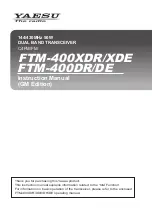
TIMTER™ Multi-mode Digital Telemetry Transmitter
100
Quasonix, Inc.
12 Appendix C
– Understanding Clock/Data, AC, and BR
It is important to understand clock and data priorities when using a Quasonix transmitter. Table 21 describes the
possible settings for Internal Clock, Clock Free, Clock Free Bit Rate, External Clock, External Data, and Automatic
Carrier Output, and the resulting RF output.
Clock and data logic (where they come from and how they are selected) is shown in Figure 42.
When set to internal clock source (CS 1), the data source must also be set to internal via the DS command (DS 1) in
order to have synchronous, usable data.
For details about specific commands, refer to AC, BBCK, BR, CF, or IC.
Table 21: Transmitter Priority of CS, CF, BR, and AC When RF is On
CS
CF
BR
auto/manual
Ext Clk In
Ext Dat
In
AC
RF Out
1
x
x
x
x
x
RF out is based on IC and ID
0
0
Auto
x
present
x
RF out is based on auto CF rate
derived from ext data input
0
0
Auto
x
not
present
0
RF Off
0
0
Auto
x
not
present
1
RF stick at Carrier frequency
0
0
Manual
x
x
x
RF out based on BR setting (may be
trash if no data is present or rate is
wrong on ext dat input)
0
1
x
present
x
x
RF out based on ext clock and data
(may be trash if no data is present
on ext dat input)
0
1
x
not
present
x
0
RF Off
0
1
x
not
present
x
1
RF stick at Carrier frequency
*Note that ‘x’ means ‘don't care’
Содержание TIMTER QSX-V Series
Страница 39: ...TIMTER Multi mode Digital Telemetry Transmitter 31 Quasonix Inc Figure 22 Baseband Signal Timing ...
Страница 101: ...TIMTER Multi mode Digital Telemetry Transmitter 93 Quasonix Inc Figure 41 Shock Pulse X axis Negative ...
Страница 109: ...TIMTER Multi mode Digital Telemetry Transmitter 101 Quasonix Inc Figure 42 Transmitter Clock and Data Logic ...





































